The most famous celebrity in Ketchum is a dead man. His grizzled mug gazes out at you from signposts and store windows all over town. The elementary school is named for him, as are a half-dozen other small businesses and parks. He is buried in the local cemetery. Still, it was ten years before I realized Ernest Hemingway and I were neighbors.
Fifteen years ago, my husband and I traveled to Ketchum, Idaho and were awestruck by the jagged drama of the Sawtooth Mountains, the cheerful flickering aspens, the fresh, blade-sharp air that scraped the L.A. smog from our lungs. Addled by the town’s charm, we made an offer on a house, rationalizing that a vacation home in the wide-open spaces might facilitate the blending of our soon to be blended family.
The house was (is) a homely, ramshackle thing with clumsy additions cobbled on by a series of owners. Our family spent years of school holidays there, summertime biking and fishing, and wintertime skiing and sledding. Now that the kids are grown, most of the time it’s just my husband and myself (and the dog) mucking around the place, the old walls silently echoing with bygone battles over bathroom time.
Ketchum is the home of the Sun Valley ski resort, so it attracts its share of celebrities. Stumbling across Tom 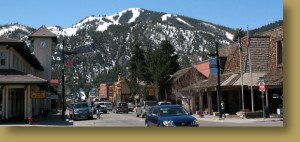 Hanks in the lift line, Arnold Schwarzenegger eating a hamburger, Clint Eastwood dropping off his rentals, causes less of a stir than a moose sighting. But a few years back when the Nature Conservancy advertised a rare Ernest Hemingway house tour, I leapt at the chance of getting some inside scoop on Ketchum’s literary lion. Imagine my shock at finding the house was located on the dirt road that forked off my own street—an honest-to-God ‘stones throw’ from my front porch, if I didn’t throw like a girl. I’d walked past it countless times and never noticed it.
Hanks in the lift line, Arnold Schwarzenegger eating a hamburger, Clint Eastwood dropping off his rentals, causes less of a stir than a moose sighting. But a few years back when the Nature Conservancy advertised a rare Ernest Hemingway house tour, I leapt at the chance of getting some inside scoop on Ketchum’s literary lion. Imagine my shock at finding the house was located on the dirt road that forked off my own street—an honest-to-God ‘stones throw’ from my front porch, if I didn’t throw like a girl. I’d walked past it countless times and never noticed it.
The Hemingway house isn’t much to look at. It is neither large and lavish, nor crafty and charming. It does possess a spectacular view from the rear porch, perched high above the Big Wood River. The interior looks a lot like your grandparent’s house in Fresno; thin grey carpet, musty wood paneling, saggy upholstered chairs. Unlike your grandparent’s house, the walls are festooned with mounted heads of various deer-like animals, each something more rare and splendid than a plain-old-deer; rare beasts with curly horns and exotic markings on their pretty faces. I don’t know if Hemingway killed all the trophy animals in the house—but he’s sort of famous for killing things, so he very well may have. Still, arranging all those heads seems a funny way to make a house feel more like a home.
Of course, everyone on the tour, myself included, lingers in the foyer where, according to the New York Times, on July 3, 1961, “The body of the bearded, barrel-chested writer, clad in a robe and pajamas, was found by his wife… A double-barreled, 12-gauge shotgun lay beside him with one chamber discharged.” Nearly forty years later, there is no remaining evidence of Hemingway’s grisly suicide, but we all mill about just the same, squinting and imagining, some, like myself, shame-faced by their morbid curiosity, others gaily posing and snapping photos.
For a while, there was a groundswell of interest in making the Hemingway house a real tourist destination, complete with a shuttle ferrying visitors up and down that dirt road. Our neighbors directly across the street didn’t like the idea one bit. Their huge, swanky house is bordered by that dirt road on the east. So they acquired a tiny spot of land on the far side of the road on which they built a fancy shed, thus, per some zoning law, turning that dirt road into a private driveway—with plenty of no trespassing signs. Depending on what sort of Ketchumite you are, you either interpret this action as a private citizen protecting his property rights, or as a one-percenter denying the public access to an important landmark. Ketchum has always been a place where there are plenty of voices in both these camps.
I fall into a third camp: one that believes the house shouldn’t be a tourist site at all. Although Hemingway lived and worked in Ketchum for a meaningful part of his life, residing at the Sun Valley Lodge in the late 1930’s while he worked on For Whom the Bell Tolls, the house on the Big Wood River was purchased just two years before he died. He arrived there sick and frail, and became even sicker and frailer, spending most of his final years ensconced in far away hospitals.
In fact, Hemingway had only been ‘home’ for two days following a two-month stay at the Mayo Clinic in Minnesota—where he’d been receiving treatment for hypertension and what a Mayo spokesman called a “very old” case of hepatitis—when he crept downstairs early in the morning (so as not to wake his slumbering wife), opened the gun cabinet, removed a shotgun, and blew his brains out.
I didn’t know much of this history before my tour, and didn’t learn any details from the blandly smiling docent who did little more than point out a few sepia photos of a robust, grinning Hemingway attired in khaki and waders. But having learned it, I understand why my neighbors took measures to prevent shuttles full of suicide gawkers and ghost hunters and conspiracy theorists from poking around in their bushes for souvenirs
In the past few years it has occurred to me that in blowing his brains out, Ernest Hemingway made it acceptable for other ‘manly’ men to blow their own brains out. Along with the perfect six-word story, (“for sale: baby shoes, never worn”) and brilliantly spare prose, and arguably one-dimensional female characters; suicide-by-gun might be Hemingway’s legacy. Or perhaps his father deserves the credit, as he also blew his brains out, which made it a viable option for Ernest, and so on and so on. These words might sound brutal and callous, or worse, judgmental, but this is not the sentiment with which I put them on the page.
It might come as a surprise that blowing your brains out has long been the preferred method of suicide in the United States. According to the U.S. Centers for Disease Control and Prevention (CDC): “In 2010, firearms were the most common method of death by suicide, accounting for a little more than half (50.6%) of all suicide deaths. The next most common methods were suffocation (including hangings) at 24.8% and poisoning at 17.3%.” These numbers have held fairly steady as long as such records have been kept.
And for as much as the media makes it appear as if America’s young people are tragically offing themselves left and right, the highest suicide rate has consistently been among men 45 to 64 years old. Suicides are much more frequent among males than among females, and without getting into the breakdowns of all the racial data, let’s just say white.
Not only are women far less likely to commit suicide, but when they do they are tidier about it. My feelings about suicide are complicated, but I find the macho savagery of forcing a complete stranger, or worse, someone who loved you the best they knew how, to clean up the messy remains of your final ‘fuck-you’ to the world, appalling. It is the sort of loud, abrasive death that most women shy away from. Women take pills. Even our famous female literary suicides were non-violent. Sylvia Plath gassed herself. Virginia Woolf walked into the river with stones in her pockets and drowned. You don’t get much quieter than that.
Although, as the saying goes, there are statistics and there are statistics. The thing about a shotgun, is it will do the trick. There is no backsliding, no turning back, no panicked, remorseful 911 call. There is also less opportunity to designate the death as accidental.
He was cleaning the gun and it went off.
Hemingway’s widow chose to believe that, but I doubt anyone else did, or does, in shot-to-the-head cases. An accidental overdose is pretty common, asphyxiation is a game that fringe-types play for kicks, and it’s possible to lose your balance and fall in front of a moving train. Killing yourself is not the same as committing suicide. Perhaps the numbers would skew differently if everyone left a nice, clear note like they do in the movies, something that indicated intent.
Until they do, Hemingway’s choice appears to be America’s choice.
Where do all these middle-aged gun eaters come from? Mostly, they reside in a region in the Western part of the country that so exceeds national norms that social scientists have christened it, “the suicide belt,” wrapping itself around Montana, Wyoming, Idaho, Nevada, and Alaska; rugged mountain states full of wide-open spaces, and plenty of firepower.
My family made our annual trek to Ketchum this past December. The town was packed, as it always is around Christmas. Sun Valley really knows how to do the holidays. There are sleigh rides and massive feasts, and every tall tree twinkles with faerie lights.
Then two days after the New Year, a young man shot himself.
I was in a yoga class of all things, when at the end of shavasana the instructor asked us all to remember a local family in our prayers. A ripple went through the room, a sudden intake of breath. As an outsider, I wasn’t going to ask questions, but news, especially bad news, travels fast in a small town. By the time hundreds of folks, literally half the town, turned out for his candlelight vigil (he’d been a particularly beloved and popular high school senior) I’d learned the sad details.
I thought a lot about Hemingway that week. It was hard not to, since “Papa’s” face is everywhere, weather beaten beneath a heavy grey beard, his eyes gentle and sad. I thought a lot about the mythology of the west, about the men of Ketchum.
At our favorite breakfast spot, the Kneadery, a log building with a old-timey saloon feel, including a huge 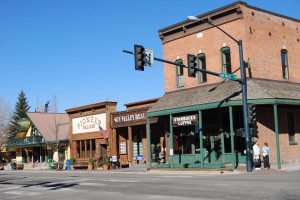 taxidermied bear at the register, one of the items on the menu is Michael’s omelet— three eggs, sausage, spinach, and jack cheese. If you ask one of the young waitresses who Michael is, they will tell you he was the original owner who died in 2002. If you ask one of the older waitresses how he died, they will admit it was a self-inflicted gunshot wound.
taxidermied bear at the register, one of the items on the menu is Michael’s omelet— three eggs, sausage, spinach, and jack cheese. If you ask one of the young waitresses who Michael is, they will tell you he was the original owner who died in 2002. If you ask one of the older waitresses how he died, they will admit it was a self-inflicted gunshot wound.
Because we don’t live in Ketchum year round, we employ a caretaker/handyman who makes sure our pipes don’t freeze and the raccoons don’t move in. He is a kind and quiet man, and for years I thought he had a speech impediment. Then my husband informed me that the reason our lovely and soft-spoken handyman is so soft spoken is because at the last moment he flinched, and the gun only took off part of his jaw. The doctors mended him the best they could. You can hardly tell.
A girlfriend of mine works at St Luke’s, the large, modern hospital that serves Ketchum and the Wood River Valley, specifically in the community outreach program. Through her (and the arrest blotter in the local paper) I’ve learned that you can flip over a pretty little mountain town and underneath find the same ugly issues with drugs and alcohol and depression you find anywhere else, but with less support. In the rugged west, men are not encouraged to open up about their problems. In fact, it wasn’t until just last year that St Luke’s hired its first full-time psychiatrist—ever.
Is it possible Hemingway’s method of suicide was necessary in order for him to remain authentic to his brand? Who wants to see a man whose entire oeuvre is based on an outsized masculine vitality dodder through his golden years in diapers?
Maybe some men were never meant to grow old. This sentiment was expressed much more eloquently than I could ever hope to by journalist Hunter S. Thompson who visited Ketchum in 1964 to write what has been described as, “a masterpiece of gentle empathy,” about the writer he so admired.
“He was an old, sick, and very troubled man, and the illusion of peace and contentment was not enough for him – not even when his friends came up from Cuba and played bullfight with him in the Tram. So finally, and for what he must have thought the best of reasons, he ended it with a shotgun.”
Thompson must have bought into the Hemingway mythology, because forty-one years later at his “fortified compound” in Woody Creek, Colorado, he also died from a self-inflicted gunshot wound to the head.
I will be back in Ketchum in two weeks. I will ignore the No Trespassing! Private Drive! sign, and I will walk my dog down that old dirt road. There will still be snow on the ground. Like most dogs, my dog is nuts for snow. He will run and frolic (a ridiculous word, frolic, but sometimes the best word) and my heart will swell with that wonderful feeling one gets watching the pure, joyful giddiness only accessible to children and animals.
We will pass that silent house perched above the Big Wood River. And I will think of the sepia photos inside of a vigorous bear of a man pulling trout shiny from the water. I will think of a boy’s candlelight vigil, and Michael’s omelet, and my quiet caretaker, and all the men who came to a place in their lives so dark they saw no alternative. And I will wonder, how does a man lose hope in Ketchum, where the beauty of the world, immense and undeniable, surrounds you at every turn? Then again, maybe that’s the crux; if a man cannot find peace of mind in this slice of God’s country, perhaps it becomes impossible for him to believe it exists anywhere on this earth.
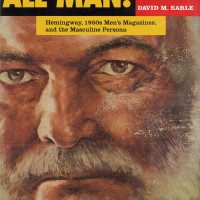
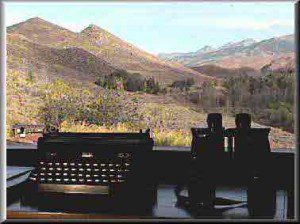

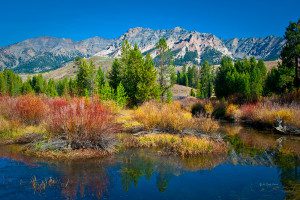




6 responses
These days it takes some mighty fine prose to keep me reading…just so busy, right? This piece wouldn’t let me go.
What a beautiful piece, on so many levels. Thank you so much for writing this and Rumpus publishing it.
Thank you for this essay. My daughter sent it to me; I have followed Hemingway’s life and writing for 25 years. Your essay is inspiring. You said it well!
Your last sentence…undeniable truth.
Quote:
“My feelings about suicide are complicated, but I find the macho savagery of forcing a complete stranger, or worse, someone who loved you the best they knew how, to clean up the messy remains of your final ‘fuck-you’ to the world, appalling.”
My guess is that few people who commit suicide do so to say “fuck-you”; so why do they do it? I think most are at the end of their rope – they feel they are out of good options or that suicide is the least unpleasant option. They see a future that is unacceptable – I suspect the majority are probably correct! Men age 45-64 (mentioned in the article) may have suffered a job loss due to age discrimination, or they may see a future with: increasing health difficulties, future retirement without adequate funds and no pension, etc. There should be no surprise that they have a higher incidence of suicide. Sadly, many probably made the right choice – even sadder is how society turned their backs on these people and forced them to use some heinous, violent method when humane methods exist (but have been made unavailable).
To make the survivors feel better, we create suicide hotlines, and other measures and say “Why didn’t he go get help?”. He didn’t want help – he wanted OUT.
We visited our daughter who lived in Guatemala while she was in the Peace Corps. We traveled to the ATlantic coast and stayed at a hotel that had floating rooms just at the edge of the water. The bar was also a floating platform. I was sitting there, so relaxed and enjoying my drink. The thought came to my mind: I am waiting for Ernest to come join us. Thinking of him at that moment really set the memory of that place and time in my mind. It’s a really good memory.
Click here to subscribe today and leave your comment.